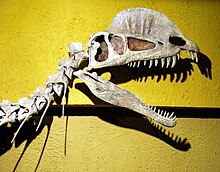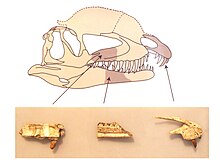Dilophosauridae
| Dilophosauridae | ||||||||||||
|---|---|---|---|---|---|---|---|---|---|---|---|---|

Life picture of Dilophosaurus wetherilli , the type species of the family. |
||||||||||||
| Temporal occurrence | ||||||||||||
| Lower Jurassic ( Hettangian to Sinemurian ) | ||||||||||||
| 201.3 to 190.8 million years | ||||||||||||
| Locations | ||||||||||||
| Systematics | ||||||||||||
|
||||||||||||
| Scientific name | ||||||||||||
| Dilophosauridae | ||||||||||||
| Charig & Milner , 1990 | ||||||||||||
| Genera | ||||||||||||
|
The Dilophosauridae are a controversial family of medium-sized theropods . Dilophosaurids were among the first larger carnivorous dinosaurs , fossils are currently only known from the Lower Jurassic , but some recent finds may also suggest they were found in the Triassic .
description
Dilophosauriden were medium-sized carnivores that reached lengths of around four to seven meters, weighing around 500 kilograms. In some genera such as Dilophosaurus , Cryolophosaurus and Sinosaurus , the bony crests of the skull are particularly striking . Dilophosaurids differ in detail from other theropod dinosaurs mainly on the basis of features of the lower jaw . With more advanced theropods they already share the presence of smaller cranial openings in the snout area (promaxillary window ), a vascular opening in the lacrimal bone and a reduced number of teeth in the upper jaw .
Systematics
It is currently controversial whether the Dilophosauriden exist as a taxon at all or whether the proposed genera are only different early theropods that were not closely related. In general, the relationships of the early neotheropods are controversial. Hendrickx et al. (2015) defined the Dilophosauridae as the smallest group within the theropods that contains Dilophosaurus wetherilli , but not Coelophysis bauri , Ceratosaurus nasicornis and house sparrow .

Yates (2005) reservedly described a common clade of Dilophosaurus , Dracovenator and Zupaysaurus . Smith et al. (2007) found a common group composed of Dilophosaurus , Cryolophosaurus , Sinosaurus (= " Dilophosaurus " sinensis ) and Dracovenator . Other authors such as Carrano et al. (2012) and Hendrickx & Mateus (2014) assign the type species Dilophosaurus wetherilli to the Coelophysoidea , while they assign Cryolophosaurus and Sinosaurus to the Tetanurae . In an analysis by Hendrickx et al. (2015) resulted in a Dilophosauridae from Dilophosaurus and Dracovenator . Dal Sasso et al. (2018) found Sarcosaurus in a common clade with Dilophosaurus and Cryolophosaurus . Zahner & Brinkmann (2019) discuss whether the Triassic Notatesseraeraptor is also a member of the Dilophosauridae.
Cladogram according to Smith et al. (2007):
| Neotheropoda |
|
||||||||||||||||||||||||||||||||||||||||||
|
|

Cladogram according to Hendrickx and Mateus (2014):
| Theropoda |
|
||||||||||||||||||||||||||||||||||||||||||
|
|

Kladogram according to Zahner & Brinkmann (2019):
|
|
|
||||||||||||||||||||||||||||||||||||||||||||||||
|
|
Individual evidence
- ↑ a b c d Zahner, M., & Brinkmann, W. (2019). A Triassic averostran-line theropod from Switzerland and the early evolution of dinosaurs. Nature ecology & evolution, 3 (8), 1146-1152. doi: 10.1038 / s41559-019-0941-z
- ↑ a b c d Hendrickx, C., Hartman, SA, & Mateus, O. (2015). An overview of non-avian theropod discoveries and classification. PalArch's Journal of Vertebrate Palaeontology, 12 (1).
- ↑ a b Smith, ND, Makovicky, PJ, Hammer, WR, & Currie, PJ (2007). Osteology of Cryolophosaurus ellioti (Dinosauria: Theropoda) from the Early Jurassic of Antarctica and implications for early theropod evolution. Zoological Journal of the Linnean Society, 151 (2), 377-421. doi: 10.1111 / j.1096-3642.2007.00325.x
- ^ Yates, AM (2005). A new theropod dinosaur from the Early Jurassic of South Africa and its implications for the early evolution of theropods. Palaeontologia Africana , 41, 105-122.
- ^ Carrano, MT, Benson, RB, & Sampson, SD (2012). The phylogeny of Tetanurae (Dinosauria: Theropoda). Journal of Systematic Palaeontology, 10 (2), 211-300. doi: 10.1080 / 14772019.2011.630927
- ↑ a b Hendrickx, C., & Mateus, O. (2014). Torvosaurus gurneyi n. Sp., The largest terrestrial predator from Europe, and a proposed terminology of the maxilla anatomy in nonavian theropods. PLoS One, 9 (3), e88905. doi: 10.1371 / journal.pone.0088905
- ↑ Dal Sasso, C., Maganuco, S., & Cau, A. (2018). The oldest ceratosaurian (Dinosauria: Theropoda), from the Lower Jurassic of Italy, sheds light on the evolution of the three-fingered hand of birds. PeerJ, 6, e5976. doi: 10.7717 / peerj.5976